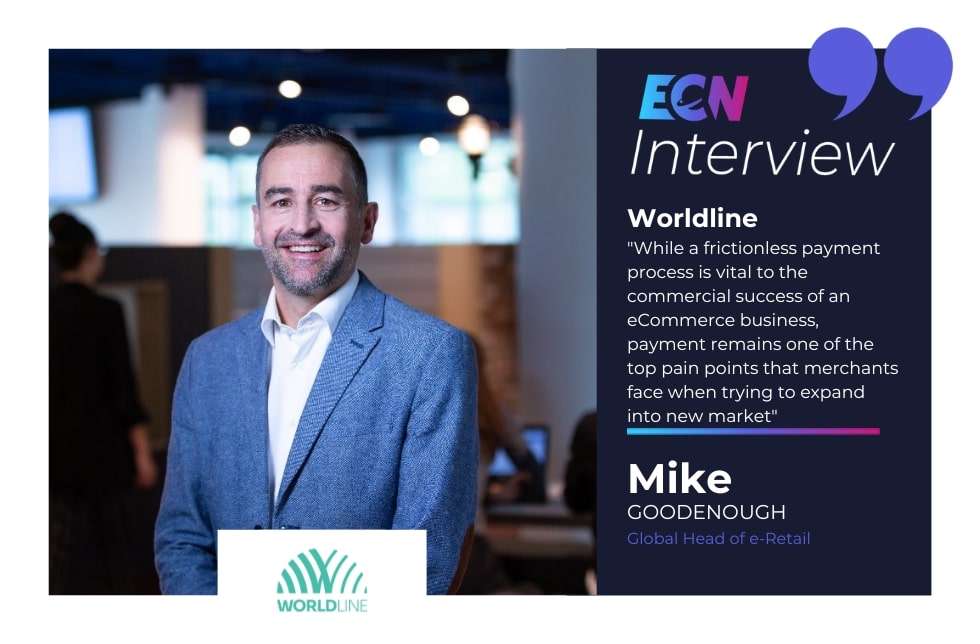In partnership with Merchant Payments Ecosystem 2022, E-Commerce Nation had the pleasure to interview Mike Goodenough, Global Head of e-Retail at Worldline. Together we discussed payment solutions for e-merchants, the strategies adapted to the needs of today’s consumers, and the blocking points observed by Worldline.
Can you introduce yourself and your background?
I have been fortunate to have worked in payments and eCommerce for more than 25 years during some significant changes in technology and consumer behaviour, including issuing banks, card schemes, merchants and PSP’s.
Currently Global Head of e-Retail for Worldline, other roles in over the last 14 years in this organisation have included GM of EMEA, managing the Global Partnerships and Alliances team leading product teams, sales teams and advising on M&A opportunities.
I am a charismatic leader who is well-known within the industry as a payments expert.
Can you introduce Worldline and its activities?
Worldline is the European leader in the payments and transactional services industry and #4 player worldwide. With its global reach and its commitment to innovation, Worldline is the technology partner of choice for merchants, banks and third-party acquirers as well as public transport operators, government agencies and industrial companies in all sectors.
Our solutions target global online businesses who need a partner for global growth. Our experience and expertise across the many sectors we serve help our customers to deliver the payment experience their global customers want. On top of this, we have dedicated teams organized by industry vertical. Not only our sales but also operations, customer service, and product are fully dedicated to addressing the needs of these customers. This combines the in-depth knowledge per industry with the breadth of our market coverage throughout the world.
How do you advise merchants to digitalize their business?
While a frictionless payment process is vital to the commercial success of an eCommerce business, payment remains one of the top pain points that merchants face when trying to expand into new markets. It is almost impossible to operate a seamless cross-border eCommerce business without a scalable and reliable way to process payments.
With the rise of online retail and increasing globalization driven by changing consumer demands, there has never been a more critical time for businesses to extend their reach across borders. This increasing demand for cross-border processing capabilities also results in a potential rise in costs, transaction processing, through currency exchange fees and chargeback risk.
Managing and mitigating these risks are crucial factors in achieving international growth for any business. Entrusting your eCommerce expansion to a trusted, experienced partner is vital to the execution of a successful global expansion and the achievement of long-term sustainable growth.
What are the blocking points that you encounter the most with your clients?
Clients’ most significant challenge when entering new markets was understanding how to cater to customers’ needs and expectations in different regions whilst also adapting to recent changes in consumer behaviour. Partnering with payment service providers (PSPs) helps them gain this knowledge, as their expert teams have developed expertise and understanding of consumer demand in different regions by working for many years in countries across the globe.
With high-growth markets becoming essential to European eCommerce businesses looking to expand internationally, they must learn how to enter these markets with the most excellent chance of success. At Worldline, we’ve launched many local domestic solutions through a single connection that help reduce the barriers to entry. These solutions, coupled with a relationship management model built on deep understanding of our clients needs, have helped many eCommerce companies successfully break into these rapidly expanding markets.
What are the solutions that you put in place to support them?
Global eCommerce is growing rapidly, and the pandemic is accelerating the shift towards a more digital world and triggering changes in online shopping behaviours. Today’s consumers demand the entire digital experience to cater to their needs and preferences. However, many companies struggle to apply their UX-driven business approach to the payment experience – especially on a global scale, where there is significant variation in preferred payment methods, currencies, and mobile usage in different localities. We offer a range of solutions specifically designed for businesses to reach peak payment conversion. These products are built for online consumers who demand fast, mobile, and secure payments with preferred payment methods and currencies.
Another key focus area for us is high-growth eCommerce markets such as South Korea, Latin America, and India. These markets can be hugely beneficial for companies looking to operate internationally, and we see cross-border sales continuing to take off in these regions. South Korea and Latin America have some of the most significant potentials for digital commerce growth, and those operating across borders should consider offering services there. The key to achieving this is the ability to provide payment services that meet customers’ needs in different localities. Worldline research has found that up to 42% of customers are likely to drop off and search for an alternative website if their preferred payment method is not offered at the checkout. Therefore, businesses must integrate with payment networks in different regions to provide locally relevant payment methods. We have solutions for traditionally complex geographies and continue to deliver solutions for more of these markets.
What are the elements to take into account for an online store wishing to expand internationally?
Many markets, especially growth or developing markets can have high barriers to entry; a complex payment ecosystem, different payment methods, and robust regulations that have to be upheld to enter those markets.
There are five primary enablers of cross-border:
- The rise of direct-to-consumer model
- Multiple consumer touchpoints and social commerce
- Lower prices and greater choice
- Improved localization
- The role of innovation as an enabler
When expanding into a new market it’s essential to understand local consumer behaviour and requirements. Customers in different regions around the world interact differently with eCommerce businesses when it comes to payments. A payment experience that is perfectly matched to the customer’s needs can not only help them smoothly complete a transaction, but can also increase loyalty, boost repeat custom and elevate brand perception.
You recently talked about the differences between the West and the East in the use of digital wallets, can you tell us more?
In Western developed markets, most digital wallets evolved from card payment rails. PayPal, Apple Pay, and Google Pay allowed customers to convert a card-initiated payment into a mobile payment utilizing the card account as the underlying payment method.
Conversely, across Asian markets, wallets have evolved from different sources. Often, they are strongly tied or integrated to the Super Apps available across these markets. The major wallets of Alipay and WeChat Pay dominate China, but across other Asian markets, companies like Gcash, Gojek, Grab, and Bukalapak now have multi-billion dollar valuations and enormous local market shares. Across Asia, these solutions have embedded themselves by providing a more holistic approach through their Super Apps, which offer a range of services accessible by consumers with a payment component embedded in this experience.
Significantly these “eastern” wallets have often developed as a store of value in the region, providing an attractive capacity for unbanked and underbanked populations to participate in the digital economy. In India, digital wallets are not necessarily stores of value but provide consumers the ability to pass through payments via the UPI network that facilitates real-time payments. Compared to Europe and the US, the market across Asia is much bigger, with some 1.8 billion digital wallets in use in the Asia Pacific region.
There is active work by many of these wallet providers to make them just as accessible for their customers offshore as they are local. Alipay has been cooperating with six European mobile wallet providers to promote interoperability in the use of QR codes for digital payments. There is also an increasing number of examples where local regulators champion this interoperability of wallets between countries.
As a result of these different evolutions, the ways and expectations of how customers will utilize these services in a retail environment will also be different. While Western wallets will primarily operate via merchant terminal infrastructure, the eastern wallets are far more likely to work via real-time transfer or QR code payment activation. These payments can be activated in-store by a simple QR code scanned by the customer, a cheaper and less technologically dependent payment process. As a result, they can offer merchants a low cost of entry and attract a customer base that is much more familiar and confident with this payment method.
Retailers that have or aspire to have a customer base in, or coming from, the east should consider how these trendy and very trusted wallet products might be introduced into their existing payment options.
What payment trends do you think will develop in the next 5 years?
The growth of new technologies as well as the rising importance these innovations hold in the Fintech space are expected to continue and perhaps even accelerate throughout 2022 for the benefit of merchants. Such technologies include Artificial Intelligence (AI) & Machine Learning (ML) driven data analytics, block chain based digital currencies – for example a central bank digital currency (CBDC) effectively the digital form of a fiat currency – embedded payments (e.g. in-vehicle or home assistant payments).
The rise of social commerce and the explosion of live-shopping driven by embedded payment capabilities in that experience, particularly in eRetail, will change the way consumers make purchases
By adopting these technologies, retailers will be able to use data to tailor their products towards the bespoke needs of their customers and streamline their processes to bolster revenue.
We are talking to each other in the context of the MPE. Is this your first participation? What is its added value?
We are excited to be sharing our knowledge and expertise with the industry and our peers, interested in learning about exciting new developments in the industry and region and of course meeting businesses that we can help grow.
Register to the event with our code MPE22-ecomm-nation-10





